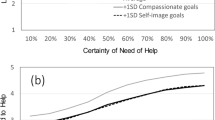Abstract
Several theoretical perspectives in the social psychology literature on helping suggest that people forecast the benefit that they will receive as a result of helping others, and help only if they determine that it is rewarding to do so. One type of self-benefit that can be received from helping is an enhancement of positive mood. The major hypotheses of the present study were: (1) women, to a greater degree than men, would expect to experience enhanced positive mood as a consequence of both helping and receiving help in a relational context; and (2) those who are high in compassionate love for others would expect to experience enhanced positive mood from giving and receiving help relative to those who are lower on compassionate love. Support was found for both hypotheses. In addition, women were more likely than men to rate certain helping behaviors in a relational context (e.g., providing verbal support) as good examples of “compassionate love acts.” The meaning of the results with respect to altruism and for gender differences in helping behavior is discussed.
Similar content being viewed by others
References
Batson, C. D. (1998). Altruism and prosocial behavior. In D. T. Gilbert, S. T. Fiske, & G. Lindzey (Eds.), The handbook of social psychology (pp. 282–316). Boston: McGraw-Hill (4th ed.).
Buss, D. (1988). Love acts: The evolutionary biology of love. In R. L. Sternberg & M. L. Barnes (Eds.), The psychology of love (pp. 100–118). New Haven, CT: Yale University Press.
Cialdini, R. B., Darby, B. L., & Vincent, J. E. (1973). Transgression and altruism: A case for hedonism. Journal of Experimental Social Psychology, 9, 502–516.
Cohen, S., Underwood, L. G., & Gottlieb, B. H. (Eds.) (2000). Social support measurement and intervention: A guide for health and social scientists. New York: Oxford University Press.
Dovidio, J. F., & Penner, L. A. (2001). Helping and altruism. In G. J. O. Fletcher & M. S. Clark (Eds.), Blackwell handbook of social psychology: Interpersonal processes (pp. 331–356). Oxford, UK: Blackwell.
Eagly, A. H. (1987). Sex differences in social behavior: A social-role interpretation. Hillsdale, NJ: Erlbaum.
Eagly, A. H., & Crowley, M. (1986). Gender and helping behavior: A meta-analytic review of the social psychological literature. Psychological Bulletin, 100, 283–308.
Harris, M. B. (1977). Effects of altruism on mood. Journal of Social Psychology, 102, 197–208.
Liang, J., Krause, N. M., & Bennett, J. M. (2001). Social exchange and well-being: Is giving better than receiving? Psychology and Aging, 16, 511–523.
McGuire, A. M. (1994). Helping behaviors in the natural environment: Dimensions and correlations of helping. Personality and Social Psychology Bulletin, 20, 45–56.
Oliner, S. P., & Oliner, P. M. (1988). The altruistic personality: Rescuers of Jews in Nazi Europe. New York: Free Press.
Otten, C., Penner, L. A., & Waugh, G. (1988). That’s what friends are for: The determinants of psychological helping. Journal of Social and Clinical Psychology, 7, 34–41.
Penner, L. A., Fritzsche, B. A., Craiger, J. P., & Freifeld, T. S. (1995). Measuring the prosocial personality. In J. N. Butcher & C. D. Spielberger (Eds.), Advances in personality assessment (vol. 12; pp. 147–163). Hillsdale, NJ: Erlbaum.
Piliavin, J. A., Dovidio, J. F., Gaertner, S. L., & Clark, R. D., III. (1981). Emergency intervention. New York: Academic.
Reissman, F. (1965). The “helper” therapy principle. Social Work, 10, 27–32.
Sprecher, S., & Fehr, B. (2005). Compassionate love for close others and humanity. Journal of Social and Personal Relationships, 22, 629–652.
Sprecher, S., & Fehr, B. (2006). Enhancement of mood and self-esteem as a result of giving and receiving compassionate love. Current Research in Social Psychology, 11, 227–242.
Williamson, G. M., & Clark, M. (1989). Providing help and desired relationship type as determinants of changes in moods and self-evaluations. Journal of Personality and Social Psychology, 56, 722–734.
Wills, T. A., & DePaulo, B. M. (1991). Interpersonal analysis of the help-seeking process. In C. R. Snyder & D. R. Forsyth (Eds.), Handbook of social and clinical psychology: The health perspective (pp. 350–375). New York: Pergamon.
Acknowledgements
The authors acknowledge support from the Fetzer Institute for this research.
Author information
Authors and Affiliations
Corresponding author
Rights and permissions
About this article
Cite this article
Sprecher, S., Fehr, B. & Zimmerman, C. Expectation for Mood Enhancement as a Result of Helping: The Effects of Gender and Compassionate Love. Sex Roles 56, 543–549 (2007). https://doi.org/10.1007/s11199-007-9192-6
Published:
Issue Date:
DOI: https://doi.org/10.1007/s11199-007-9192-6




